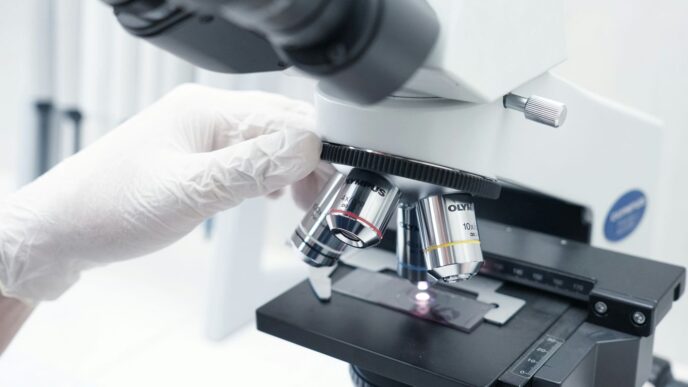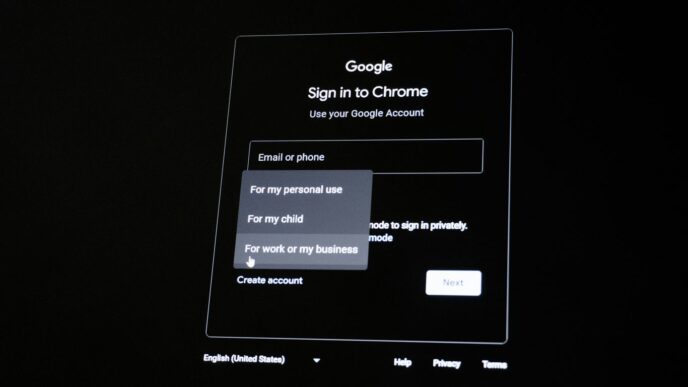Artificial Intelligence (AI) is changing the way we discover new drugs, making the process faster and more efficient. With the help of machine learning, scientists can analyze huge amounts of data to find potential treatments for various diseases. This article explores how AI is being used in drug discovery and what it means for the future of medicine.
Key Takeaways
- AI is speeding up drug discovery by analyzing large data sets quickly.
- Machine learning helps predict how well new drugs will work.
- High-quality data is essential for AI to be effective in drug development.
- AI can reduce the time and cost involved in getting new drugs to market.
- Collaborations between tech companies and pharmaceutical firms are growing.
The Role of AI in Modern Drug Discovery

Understanding AI’s Impact on Drug Development
Artificial Intelligence (AI) is changing how we discover new drugs. AI helps scientists find new treatments faster and more efficiently. By analyzing large amounts of data, AI can identify patterns that humans might miss. This means that researchers can focus on the most promising drug candidates sooner.
Key Technologies Driving AI in Drug Discovery
Several technologies are making AI effective in drug discovery:
- Machine Learning: This allows computers to learn from data and improve over time.
- Natural Language Processing (NLP): This helps AI understand and analyze scientific literature.
- Data Mining: This technique extracts useful information from large datasets.
Case Studies of AI Success in Pharmaceuticals
Here are some examples of how AI has succeeded in drug discovery:
- Insilico Medicine: Developed a drug candidate for lung disease in just 30 months.
- Atomwise: Used AI to find potential treatments for Ebola and other diseases.
- BenevolentAI: Identified a new use for an existing drug to treat COVID-19.
AI is not just a tool; it is a partner in the quest for new medicines. Its ability to process vast amounts of information quickly is revolutionizing the pharmaceutical industry.
Machine Learning Algorithms Transforming Drug Discovery
Types of Machine Learning Used in Drug Discovery
Machine learning (ML) is changing how drugs are discovered. Here are some common types of ML used:
- Supervised Learning: This involves training a model on labeled data to predict outcomes.
- Unsupervised Learning: This helps find patterns in data without pre-existing labels.
- Reinforcement Learning: This teaches models to make decisions by rewarding them for correct actions.
How Algorithms Predict Drug Efficacy
Machine learning algorithms can analyze vast amounts of data to predict how effective a drug will be. They do this by:
- Analyzing chemical structures to find similarities with known drugs.
- Using historical data from past drug trials to identify successful patterns.
- Simulating drug interactions in a virtual environment to predict outcomes.
Challenges and Limitations of Current Algorithms
Despite their potential, there are challenges:
- Data Quality: Poor data can lead to inaccurate predictions.
- Complexity: Some algorithms are too complex to interpret easily.
- Bias: If the training data is biased, the predictions will be too.
The use of machine learning in drug discovery is promising, but it requires careful handling of data and algorithms to ensure success.
Data-Driven Approaches in Identifying Drug Targets

Importance of High-Quality Data
High-quality data is crucial for successful drug discovery. Good data helps scientists make better decisions about which drug targets to pursue. Here are some key points:
- Accurate data leads to better predictions.
- High-quality data reduces the risk of failure in later stages.
- It allows for more efficient use of resources.
Techniques for Data Mining in Drug Discovery
Data mining techniques help researchers find useful information from large datasets. Some common techniques include:
- Natural Language Processing (NLP): This helps in analyzing scientific literature to find relevant information.
- Machine Learning: Algorithms can identify patterns in data that humans might miss.
- Knowledge Graphs: These organize data to show relationships between different drug targets and diseases.
Case Studies of Data-Driven Target Identification
Several companies have successfully used data-driven methods to identify drug targets. For example:
- Exscientia: Utilizes NLP to analyze vast amounts of scientific data, leading to new drug targets.
- AstraZeneca: Reports that AI has helped them discover targets they wouldn’t have considered otherwise.
- Insilico Medicine: Advanced to clinical trials with an AI-designed drug candidate, showcasing the potential of data-driven approaches.
Data-driven methods are changing how we identify drug targets, making the process faster and more efficient. By leveraging technology, researchers can focus on the most promising candidates, ultimately leading to better treatments.
Accelerating Preclinical Testing with AI
AI in Preclinical Testing: An Overview
AI is changing how we approach preclinical testing. This stage is crucial because it helps scientists understand how a drug works in the body before it goes to human trials. By using AI, researchers can analyze data faster and more accurately, leading to quicker decisions about which drugs to move forward.
Benefits of AI in Reducing Time and Costs
The use of AI in preclinical testing offers several advantages:
- Faster analysis of drug interactions.
- Reduced costs associated with traditional testing methods.
- Improved accuracy in predicting drug behavior.
Examples of AI-Enhanced Preclinical Studies
Several companies are already using AI to enhance their preclinical studies. Here are a few examples:
- Company A: Used AI to identify potential side effects early in the testing phase.
- Company B: Implemented machine learning to optimize drug formulations.
- Company C: Achieved a 30% reduction in testing time by using AI algorithms.
AI is not just a tool; it’s a game-changer in the drug discovery process. By leveraging AI, we can make smarter decisions and bring effective treatments to patients faster than ever before.
AI-Powered Drug Design and Molecular Modeling
How AI Assists in Molecular Modeling
AI is changing how we design drugs by making molecular modeling faster and more accurate. Machine learning helps scientists create models that predict how drugs will behave in the body. This means researchers can test many ideas quickly without needing to make every molecule in a lab.
Predicting Drug Behavior with AI
Using AI, researchers can:
- Analyze large amounts of data to find patterns.
- Simulate how drugs interact with proteins in the body.
- Identify which drug candidates have the best chance of success.
This approach allows scientists to focus on the most promising options, saving time and resources.
Success Stories in AI-Powered Drug Design
Several companies have successfully used AI in drug design. For example:
- Insilico Medicine developed a drug candidate in just 30 months.
- Exscientia created 136 compounds for a cancer drug in one year.
- Verseon has produced 16 candidate drugs for various diseases.
These examples show how AI can speed up the drug discovery process and lead to new treatments more efficiently.
AI is not just a tool; it’s a game-changer in drug discovery, helping researchers make better decisions faster.
Natural Language Processing in Drug Discovery
Role of NLP in Mining Scientific Literature
Natural Language Processing (NLP) is a powerful tool in drug discovery. It helps researchers analyze large amounts of scientific literature quickly. By using NLP, companies can:
- Extract relevant information from millions of research papers.
- Identify connections between different studies that might not be obvious.
- Create knowledge graphs that show relationships between genes, diseases, and potential drug targets.
Building Knowledge Graphs for Drug Discovery
Knowledge graphs are essential for organizing data in drug discovery. They help visualize complex relationships and can:
- Highlight causal links, such as how one gene affects another.
- Assist in predicting which drug targets might be most effective.
- Enable researchers to focus on the most promising areas for further study.
Impact of NLP on Identifying Novel Drug Targets
The impact of NLP on drug discovery is significant. It allows researchers to:
- Discover new drug targets that were previously overlooked.
- Speed up the research process by automating data analysis.
- Improve collaboration between scientists by providing a clearer understanding of existing research.
NLP is transforming how we approach drug discovery, making it faster and more efficient. By leveraging vast amounts of data, researchers can focus on the most promising leads, ultimately leading to better treatments for patients.
In summary, NLP is revolutionizing drug discovery by enabling better data analysis, enhancing collaboration, and identifying new drug targets. Its role in mining scientific literature and building knowledge graphs is crucial for the future of pharmaceuticals.
Ethical Considerations in AI-Driven Drug Discovery
Ensuring Data Privacy and Security
In the world of AI and drug discovery, protecting patient data is crucial. Companies must ensure that:
- Data is anonymized to prevent identification of individuals.
- Strong encryption methods are used to secure sensitive information.
- Compliance with regulations like HIPAA is maintained.
Addressing Bias in AI Algorithms
AI systems can sometimes reflect biases present in their training data. To combat this:
- Diverse datasets should be used to train algorithms.
- Regular audits of AI systems should be conducted to identify and correct biases.
- Collaboration with ethicists and social scientists can help in understanding the implications of AI decisions.
Regulatory Challenges and Compliance
Navigating the regulatory landscape is essential for AI in drug discovery. Key points include:
- Understanding the requirements set by agencies like the FDA.
- Ensuring that AI-generated results are validated through rigorous testing.
- Keeping up with evolving regulations as technology advances.
The integration of AI in drug discovery holds great promise, but it must be approached with caution to ensure ethical standards are upheld.
By addressing these ethical considerations, the pharmaceutical industry can harness the power of AI while maintaining trust and integrity in the drug discovery process.
Collaborations Between AI Companies and Pharmaceutical Firms
Successful Partnerships in AI and Pharma
The collaboration between AI companies and pharmaceutical firms is becoming increasingly important. These partnerships aim to speed up drug discovery and improve treatment options. Here are some successful examples:
- Insilico Medicine: This company has developed an AI-designed drug that is now in clinical trials, targeting a serious lung disease.
- Exscientia: They have opened new labs to enhance their drug discovery processes using AI.
- Verseon: This company focuses on creating drugs for diseases that currently have limited treatment options.
Joint Ventures and Research Initiatives
Many companies are joining forces to tackle the challenges in drug discovery. Some notable initiatives include:
- Shared Resources: Companies pool their data and technology to create better AI models.
- Collaborative Research: Joint studies help validate AI predictions and improve drug efficacy.
- Funding Opportunities: Partnerships often attract more investment, allowing for larger-scale projects.
Future Prospects for Collaboration
The future looks bright for collaborations between AI and pharma. As technology advances, we can expect:
- More innovative drug solutions.
- Increased efficiency in the drug development process.
- A greater focus on patient outcomes and safety.
The combination of AI and pharmaceutical expertise can lead to breakthroughs that were once thought impossible.
In summary, the collaboration between AI companies and pharmaceutical firms is essential for advancing drug discovery and improving healthcare outcomes. Together, they can create a more effective and efficient drug development process.
The Future of AI in Drug Discovery
Emerging Trends and Innovations
The future of AI in drug discovery looks bright, with new technologies emerging every day. Here are some trends to watch:
- Increased collaboration between tech companies and pharmaceutical firms.
- Development of more accurate algorithms for predicting drug interactions.
- Use of big data to enhance research and development processes.
Potential Impact on Global Health
AI has the potential to significantly improve global health by:
- Reducing the time it takes to bring new drugs to market.
- Lowering the costs associated with drug development.
- Increasing access to medications in underserved areas.
Predictions for the Next Decade
Experts predict that in the next ten years, AI will:
- Transform how drugs are designed and tested.
- Lead to the discovery of new treatments for diseases that currently have no cure.
- Create a more efficient drug approval process, benefiting both patients and healthcare providers.
The integration of AI in drug discovery is not just a trend; it is a revolution that could change the landscape of medicine forever.
In summary, the future of AI in drug discovery is filled with promise, and its impact on healthcare could be profound. As technology continues to evolve, we can expect to see exciting advancements that will benefit patients worldwide.
Challenges and Limitations of AI in Drug Discovery
Technical Hurdles in AI Implementation
AI in drug discovery faces several technical challenges that can slow down progress. Some of these include:
- Data Quality: Poor quality data can lead to inaccurate predictions.
- Integration Issues: Combining AI systems with existing workflows can be complex.
- Scalability: Many AI models struggle to scale effectively across different projects.
Overcoming Data Quality Issues
To ensure AI systems work effectively, it is crucial to address data quality. Here are some strategies:
- Data Cleaning: Regularly update and clean datasets to remove inaccuracies.
- Standardization: Use consistent formats for data entry to improve reliability.
- Validation: Implement checks to verify data accuracy before use.
Balancing Innovation with Safety
While AI can speed up drug discovery, it is essential to maintain safety standards. This balance can be achieved by:
- Rigorous Testing: Ensure all AI-generated candidates undergo thorough testing.
- Regulatory Compliance: Follow guidelines set by health authorities to ensure safety.
- Transparency: Maintain clear documentation of AI processes to build trust.
AI has the potential to revolutionize drug discovery, but it must be used responsibly to ensure patient safety and data integrity.
AI in Clinical Trials: Enhancing Efficiency and Accuracy
AI’s Role in Designing Clinical Trials
AI is changing how clinical trials are designed. By analyzing data, AI can help researchers create better trial plans. This means fewer mistakes and faster results. Here are some ways AI is making a difference:
- Patient Selection: AI can find the right patients for trials, ensuring that the drug is tested on those who will benefit most.
- Trial Design: AI helps in creating more effective trial designs, which can lead to quicker approvals.
- Data Analysis: AI can analyze trial data in real-time, allowing for faster decision-making.
Improving Patient Recruitment with AI
Recruiting patients for clinical trials can be tough. AI can help by:
- Identifying Candidates: AI tools can sift through medical records to find potential participants.
- Engaging Patients: AI can send personalized messages to patients, encouraging them to join trials.
- Reducing Dropouts: By monitoring patient progress, AI can help keep participants engaged and reduce dropouts.
Case Studies of AI in Clinical Trial Management
Several companies are using AI to improve their clinical trials. Here are a few examples:
- Insilico Medicine: This company used AI to design a drug that moved to clinical trials in just 30 months.
- Exscientia: Their AI technology helps match patients to trials, improving success rates.
- Pfizer: They are using AI to analyze trial data, speeding up the process of getting new drugs to market.
AI is not just a tool; it’s a game-changer in clinical trials. By improving efficiency and accuracy, it helps bring new treatments to patients faster.
| Company | AI Application | Outcome |
|---|---|---|
| Insilico Medicine | Drug design | Phase I trials in 30 months |
| Exscientia | Patient matching | Higher success rates |
| Pfizer | Data analysis | Faster drug approvals |
Investment and Funding in AI-Driven Drug Discovery
Current Investment Trends
The investment landscape for AI in drug discovery is rapidly evolving. Many investors are excited about the potential of AI to transform the pharmaceutical industry. Here are some key trends:
- Increased funding for AI startups in biotech.
- Major pharmaceutical companies are partnering with AI firms.
- Venture capital is flowing into AI-driven drug discovery projects.
Key Players and Investors
Several companies and investors are leading the charge in AI-driven drug discovery. Notable players include:
- Insilico Medicine – Known for its AI-designed drug candidates.
- Exscientia – Focuses on using AI to speed up drug development.
- Verseon – Aiming to tackle diseases with innovative AI solutions.
Impact of Funding on Innovation
Funding is crucial for innovation in AI drug discovery. It allows companies to:
- Develop new technologies and algorithms.
- Conduct extensive research and clinical trials.
- Scale operations to bring drugs to market faster.
The surge in investment is a clear sign that the industry believes in the potential of AI to revolutionize drug discovery.
Summary Table of Investment Trends
| Year | Total Investment (in billions) | Notable Deals |
|---|---|---|
| 2020 | 2.5 | Insilico Medicine, Exscientia |
| 2021 | 3.0 | Verseon, AI Pharma Ventures |
| 2022 | 4.5 | New AI startups emerging |
This table highlights the growing interest and financial backing for AI in drug discovery, showcasing a promising future for the industry.
Conclusion
In conclusion, AI is changing how we discover new drugs, making the process faster and more efficient. By using machine learning, scientists can analyze huge amounts of data to find potential treatments more quickly than ever before. This technology helps researchers identify promising drug candidates and understand how they might work in the body. However, while AI offers exciting possibilities, it is important to remember that drug discovery is still a complex process that requires careful testing and validation. As we continue to improve AI tools and techniques, we can hope for a future where new medicines are developed more rapidly, ultimately benefiting patients around the world.
Frequently Asked Questions
What is AI in drug discovery?
AI, or artificial intelligence, helps scientists find new medicines faster by analyzing large amounts of data.
How does machine learning help in drug discovery?
Machine learning uses patterns in data to predict how drugs will work, helping researchers focus on the best options.
What are the benefits of using AI in drug development?
AI can speed up the process, save money, and improve the chances of finding effective treatments.
Are there any risks associated with AI in drug discovery?
Yes, there can be issues with data quality and the potential for biases in AI algorithms.
How does AI help identify drug targets?
AI analyzes scientific data to find connections that can lead to new drug targets, making the search more efficient.
What role does natural language processing play in drug discovery?
Natural language processing helps AI read and understand scientific papers, uncovering useful information for drug development.
Can AI replace traditional drug discovery methods?
AI won’t completely replace traditional methods, but it can significantly enhance and speed up the process.
What is the future of AI in drug discovery?
The future looks promising, with ongoing advancements expected to further improve drug discovery and development.













